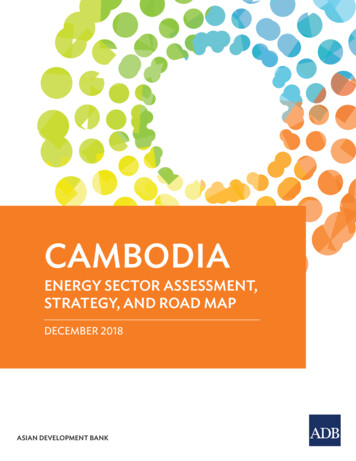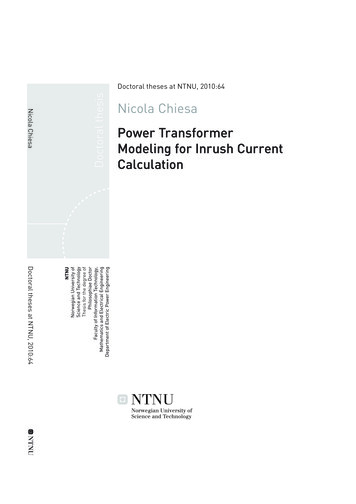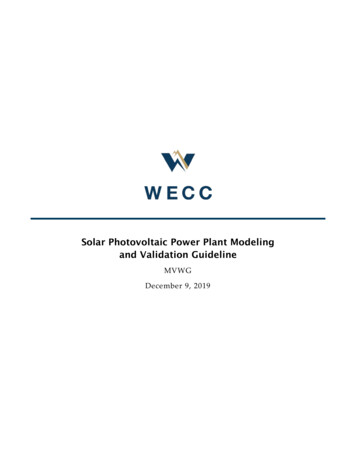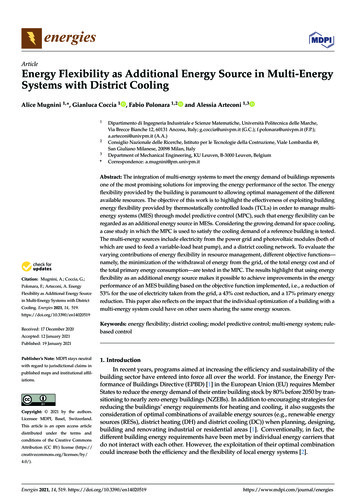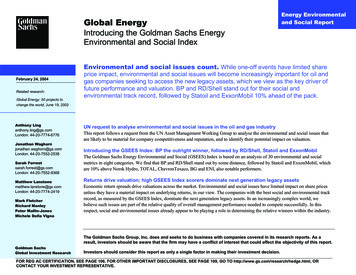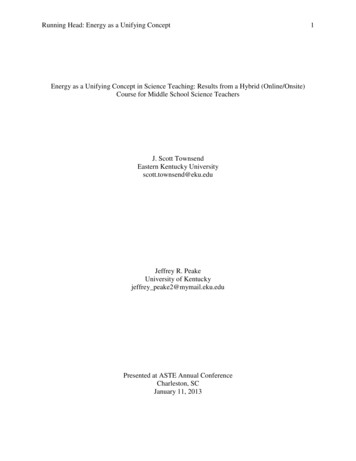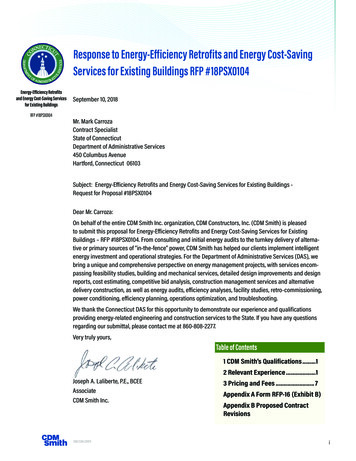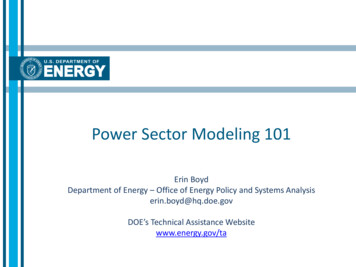
Transcription
Power Sector Modeling 101Erin BoydDepartment of Energy – Office of Energy Policy and Systems Analysiserin.boyd@hq.doe.govDOE’s Technical Assistance Websitewww.energy.gov/ta
Presentation Description – DOE Power Sector Modeling 101With increased energy planning needs and new regulations, environmental agencies, state energyoffices and others have expressed more of an interest in electric power sector models, both for(a) interpreting the results and potential applications of modeling from other groups, and (b)informing future modeling efforts a state air agency may want to initiate. This presentation coversthe basics of power sector capacity expansion modeling, and briefly touches on other types ofmodeling and analytical tools available to provide data on the electric power system. Capacityexpansion models simulate generation and transmission capacity investment, given assumptionsabout future electricity demand, fuel prices, technology cost and performance, and policy andregulation.Capacity expansion modeling topics covered in this presentation include: typical model outputs, needed model inputs, types of questions these models are well suited to answer and those they are not, key considerations when selecting a model, and key considerations when comparing model results or designing modeling scenarios.For more information on technical assistance resources available to state, local and tribal officials,visit DOE’s Technical Assistance website at www.energy.gov.ta, or submit a request atTechnicalAssistance@hq.doe.gov.2
Overview1. Power System Questions2. Model Types Data and Analysis ToolsCapacity Expansion ModelsProduction Cost (Grid Operations/Unit Commitment and Dispatch) ModelsNetwork Reliability Models3. SummaryKey Consideration: Identify the question(s) you want to answer, andthen pick the tool that will most effectively provide this information.(As opposed to picking a tool, and then finding out its not theappropriate resource to provide the information you need.)3
Examples of Power System QuestionsData and Resource AssessmentWhat are the local wind and solar resources? How much available natural gascapacity is in the region? What is the cost of avoided/saved energy consumption?Generation and Transmission Capacity ExpansionHow to plan a resource portfolio for the future (i.e., generation, retirements)?What type of generation should be built to meet demand? How much of it? Willit necessitate development of new transmission capacity? How does the optimalsystem change with constraints on emissions, or with local economicdevelopment goals? How can the system be optimized to deliver reliable powerat least-cost under specified environmental constraints? What are the costs, rateimpacts, and welfare implications of alternative power sector policies orregulations? What are the key drivers of the system?Generation and Transmission System OperationGiven a generation and transmission system what is the lowest cost way tooperate the system while maintaining reliability under uncertainty and meetingother types of constraints (e.g., emissions)?4
Power System QuestionsNetwork ReliabilityWill the transmission system work under periods of high load? Will the systembe able to remain stable after a loss of a large power plant? Will a loss oftransmission line or power system cause instability and cause individualgenerators or sections of the network to disconnect from the rest of the grid?5
Model Types1. Data and Analysis Tools – generally accessible2. Capacity Expansion Models3. Production Cost (Grid Operations/Unit Commitment and Dispatch)Models4. Network Reliability Models6
Model Types1. Data and Analysis Tools – generally accessible2. Capacity Expansion Models3. Production Cost (Grid Operations/Unit Commitment andDispatch) Models4. Network Reliability ModelsRequires expert modeler – to manage inputs,run the model, and interpret the outputs7
Data and Analysis Tools (1 of 2)Data Zero Cost Power System Tracking - capacity, generation, fuel use, fuel prices, electricityprice, electricity consumption, energy efficiency savings, policies (e.g., staterenewable portfolio standards, state energy efficiency policies)Resource Assessment - spatially and temporally explicit assessment of renewableenergy resourcesKey Resources U.S. Energy Information Agency (EIA)Database of State Incentives for Renewables and Efficiency (DSIRE)DOE's State and Local Energy Data (SLED)National Electric Energy Data System (NEEDS)EPA’s Emissions & Generation Resource Integrated Database (eGRID)EPA’s Air Markets Program Data (AMPD)National Renewable Energy Lab’s Report - Estimating Renewable Energy EconomicPotential in the United States ABB (ASEA Brown Boveri) Velocity Suite SNL Energy8
Data and Analysis Tools (2 of 2)Analysis Tools: spreadsheet tools or simple calculators that allow users to conducthigh-level gross analyses of the power sector EPA's AVoided Emissions and geneRation Tool (AVERT) - estimates the emissions implicationsof energy efficiency measures and new renewable generation capacityACEEE’s State and Utility Pollution Reduction Calculator Version 2 (SUPR 2) – 19 differentpolicies and technologies to choose from to build a compliance scenario to EPA’s Clean PowerPlan, including energy efficiency, renewable energy, nuclear power, emissions control, andnatural gas.Synapse's Clean Power Plan Planning Tool (CP3T) and MJ Bradley's & Associates CPPCompliance Tool - both Excel-based spreadsheet tools for performing first-pass planning ofstatewide compliance with EPA's Clean Power PlanAdvanced Energy Economy (AEE) State Tool for Electricity Emissions Reduction (STEER) - anopen access integrated resource planning model that constructs a merit order for dispatchfrom generator-level cost data and simulates generation based on least-cost strategies(currently available for PA, MI, AR, VA, and IL (more will be forthcoming).These analysis tools are free and publicly available.9
Capacity Expansion Models Capacity expansion models simulate generation and transmission capacityinvestment, given assumptions about future electricity demand, fuel prices,technology cost and performance, and policy and regulationWhat mix of generators should we build to meet load?Does a policy affect cost of service regions and competitive regions in differentways?Cumulative Hours at Load0200040006000800070006000Load (MW) Peak 0
Capacity Expansion ModelsTypical Outputs Annual generation, generation and transmission capacity builds/retirements,emissions, fuel consumption, electricity prices, credit/allowance prices11
Capacity Expansion Models (1 of 2) Examples of Capacity Expansion Models: National-Scale: National Energy Modeling System (NEMS), Regional EnergyDeployment System (ReEDS), Integrated Planning Model (IPM), Haiku, MARKAL(MARKet Allocation) Utility-Scale: Resource Planning Model (RPM), Aurora, System Optimizer,Strategist, PLEXOS Typically have higher spatial and temporal resolution Often used for Integrated Resource Plans (IRPs) In addition to having staff or paying an expert to run these models, thecommercial models also require a licensing fee12
Capacity Expansion Models (2 of 2) What do these models do particularly well?Examine the impacts of power sector policies (or alternative technology/fueltrajectories) on the generation and capacity mix in the mid- to long-term What don't they do?Many do not have chronological unit commitment (i.e., every hour of the yearchronologically); some use aggregate (model) plants for dispatch; transmissionand power flow are a stylized representation (pipe flow or DC) What kinds of questions/analyses can the model answer/address?Quantifying the impacts of environmental policies on generation and capacity?What are the cost implications of alternative pathways to a low greenhouse gasemissions future? How will alternative future prices of natural gas impactcapacity investment? What is the change in consumption and expenditures?What are the efficiency and distributional effects of various policy designs?13
Capacity Expansion Model Capabilities - Key Considerations inModel Selection (1 of 2) Regionality Geographic scope (state, regional, national) Cost-of-service vs. competitive regions Temporal Resolution Time of day, Seasons Time Steps Building new capacity, dispatch Time Horizon Near-term: 2015-2020, Long-term: 2015-2050 Representation of Generating Units Individual Plants or Model Plants Representation of capital costs and other production costs Representation of Transmission and Associated Constraints Pipeflow or DC Powerflow; Individual transmission lines or aggregated14
Capacity Expansion Model Capabilities - Key Considerations inModel Selection (2 of 2) Representation of Renewable Energy (RE) RE technologies represented in the modelUnderlying resource dataset – spatial and temporal resolutionAccessibility cost (connecting RE resources to load)Accounting for variability and uncertainty in generation (e.g., representationand treatment of curtailments and capacity value of RE technologies) Consideration of other parameters (e.g., electric power sector model vs.economy wide model, representation of environmental constraints)15
Capacity Expansion Model Analyses- Key Considerations whenComparing Model Results or Designing Modeling Scenarios (1 of 2) Input Assumptions Fuel prices (exogenous or endogenous) Technology cost and performance assumptions: e.g., capital cost, fixed and variable O&Mcosts, capacity factors (exogenous or endogenous) Constraints on deployment or use of specific technologies Representation of Electricity Demand Baseline Exogenous or endogenous; demand elasticity Energy efficiency representation Cost/Benefit Metrics Welfare, total cost, allowance/credit prices Distributional impacts - consumer/producer surplus, regional cost metrics Electricity Bills and Prices Competitive vs. cost-of-service Wholesale vs. retail16
Capacity Expansion Model Analyses- Key Considerations whenComparing Model Results or Designing Modeling Scenarios (2 of 2) Retirements Exogenous or endogenous Detailed Representation of Policies Ex: Carbon Policies Rate vs. mass vs. priceCovered sourcesTotal emissions vs. covered emissionsTreatment of nuclear plants, existing renewables, biomass, etc.National uniform vs. patchwork policyTrading parametersOver what time period are constraints applied (annually, compliance periods, etc.)If applicable, how is auction revenue used?If applicable, are allowances freely allocated and to who? On what basis (historic orupdating)?17
Energy Efficiency (EE) in Capacity Expansion Models EE is an energy planning resources that can reduce energybills and lower regulatory compliance costs EE representation in capacity expansion models Endogenous - rebates Exogenous Resources: EE Potential studies and EERS GoalsSource: EIA Energy Today 10/23/14; 2013 Annual CO2 Analysis18
Production Cost (Unit Commitment and Dispatch) Models Simulate operation of a specified power system over a relatively short periodcompared to Capacity Expansion Model (1-week to 1-year), but at higher temporalresolution (hours to 5-minutes)What is the least cost dispatch of a complex system of interconnected generatorsto reliably meet load in every hour of the day at every location?Capacity Expansion Output - Production Cost Input19
Production Cost (Unit Commitment and Dispatch) Models Typical Outputs: Sub-hourly unit level generation, powerflow, locationalmarginal prices, emissions, fuel consumption, loss of load, ancillary serviceprices (prices of ancillary services to balance transmission system),curtailments20
Production Cost (Unit Commitment and Dispatch) Models Examples of Production Cost Models:PROMOD, GE-Maps, PLEXOS, GridView What do these models do particularly well?Simulate detailed (hourly to sub-hourly) operation of a given system; Assessresource adequacy and other aspects of reliability of a system; Analyze theimpact of changes in the system (e.g., retirement/addition of capacity) on systemoperation; Assess transmission congestion and locational marginal prices;Describe the daily pattern of emissions What don't these models do?Build/invest in new generation or transmission capacity; Typically cannot modelthe entire US simultaneously - regional focus is required; Do not address allaspects of reliability What kinds of questions/analyses can the model answer/address?What are the operations, emissions, and resource adequacy impacts ofretirement of coal or nuclear units in a given region? What is the maximumpotential for redispatch from coal steam units to NGCCs? What is the value ofstorage, demand response, and solar power to the power system?21
Network Reliability Models: AC Powerflow and Dynamics Perform “deep-dive” simulations of the transmission network to addressspecific situations. Simulates very short time periods ( 30 sec to 1 min).Analysis includes: AC Powerflow: Simulates the AC transmission network to check operationalfeasibility (steady state)System Dynamics: Simulates dynamic events in the power system to examinereliability under fault conditions Simulation of contingency events to examine frequency response Exampleoutput: frequency nadir (lowest frequency), settling frequency Simulation of transient stability Will generators remainsynchronized with voltage spike?(e.g., lightening) Production Cost Output/Input -- Network Reliability Input/Output22
Network Reliability Models: AC Powerflow and Dynamics Network Reliability Models are typically run by ISOs/RTOs, reliabilityorganizations, large utilities, and consultants Examples: Positive Sequence Load Flow (PSLF), Power System Simulator forEngineering (PSSE) What do these models do particularly well?Detailed simulations of the transmission network including dynamic events thatcan occur in seconds (and cause big problems); these models aren't run on a dayto day basis – they are only run to examine significant changes to an existingsystem What don't these models do?Anything related to system operation in “economic” time frames (typically morethan about 30 seconds) What kinds of questions/analyses can the model answer/address?Will the system remain able to maintain frequency after retirement of largesynchronous machines with set generation and transmission mix? Will the systemmaintain reliability to respond to a voltage swing or other transients?23
What Aspects of Reliability do Different Types of ModelsAddress?Model lity,Voltage ally NoNoNoNoNoProductionCost (UnitCommitmentand NetworkReliability(AC PowerFlow,Dynamics)NoNoYesYesYesYesYes24
Summary Wide range of tools/models to address a wide range of questions Within a particular type or class of model or tool, different models havedifferent strengths and weaknesses Selection of a specific model or tool needs to be closely tied to the analyticalapplication Many assumptions to consider when comparing results from different modelsor modeling analyses Results of a modeling analysis need to be interpreted in the context of thelimitations of the model Questions?Erin Boyderin.boyd@hq.doe.govDOE Technical Assistance Websitewww.energy.gov/ta25
Appendix26
Key Data Resources (1 of 2)Key Data Resources U.S. Energy Information Agency (EIA) - independent agency that collects, analyzes, anddisseminates independent and impartial energy information Database of State Incentives for Renewables and Efficiency (DSIRE) – national and stateincentives and policies that support renewable energy and energy efficiency DOE's State and Local Energy Data (SLED) - Get basic energy market information that canhelp state and local governments plan and implement clean energy projects, including:Electricity generation; Fuel sources and costs; Applicable policies, regulations, andfinancial incentives National Electric Energy Data System (NEEDS) - database contains the generation unitrecords used to construct the "model" plants that represent existing andplanned/committed units in EPA modeling applications of IPM EPA’s Emissions & Generation Resource Integrated Database (eGRID) - data on theenvironmental characteristics of almost all electric power generated in the United States.These environmental characteristics include: air emissions for nitrogen oxides, sulfurdioxide, carbon dioxide, methane, and nitrous oxide; emissions rates; net generation;resource mix; and many other attributes27
Key Data Resources (2 of 2)Key Data Resources EPA’s Air Markets Program Data (AMPD) – tool which allows users to search EPA data toanswer scientific, general, policy, and regulatory questions about industry emissions National Renewable Energy Lab’s Report - Estimating Renewable Energy EconomicPotential in the United States – geographic economic potential for renewable energytechnologies ABB (ASEA Brown Boveri) Velocity Suite – commercial data set that includes fuelproduction, costs, electricity generation and capacity, market data, and more SNL Energy – commercial energy information that integrates news, data and analytics inreal time on a Web-based platform. Access to comprehensive financials, breaking news,proprietary regulatory research, market pricing and fundamentals of supply and demand28
What Aspects of Reliability do Different Types of ModelsAddress?Model TypeGenerator(Resource)Adequacy aFlexibilityRequirement bTransmissionAdequacy cGeneratorContingencies dTransmissionContingencies eFrequencyStability fVoltage Stability,Voltage Control gCapacityExpansionOften 1Somewhat/Depends 3Typically No 4NoNoNoNoProductionCost (UnitCommitmentandDispatch)Yes 2YesPartially 5Somewhat 6SomewhatSomewhat 8NoNetworkReliability(AC PowerFlow,Dynamics)NoNoYesYes 7YesYes 9Yes29
Footnotes for Reliability Table (slide 1 of 2)a) Defined as having adequate capacity to meet demand measured by loss of load probability in eachtime interval or cumulative loss of load expectation. Considers resource availability in each timeperiod but typically does not measure flexibility, or the ability to ramp from one state to anotherb) Defined as having adequate generator flexibility to ramp from one demand period to anotherc) Defined as not violating transmission thermal, voltage and stability limitsd) Defined as maintaining system reliability upon the failure of large generators, including the singlelargest generatore) Defined as maintaining system reliability upon the failure of transmission lines, including the singlelargest linef) Defined as maintaining system frequency by provision of inertia, primary frequency (governor)response and regulating reserves.g) Defined as the ability to maintain system voltage by provision of reactive power. NOTE we are notincluding the third leg of the stability trifecta – transient/rotor angle stability. Network reliabilitymodels are the only class of models that do this.30
1) Large-area capacity expansion models will often inforce a peak capacity requirement that is a proxyfor resource adequacy. Commercial models may often include resource adequacy calculations2) Most production cost models can provide full Loss of Load Expectation/Loss of Load Probability(LOLE/LOLP) calculations. There are also several dedicated models that perform resource adequacycalculations, including stochastics3) Most capacity expansion models do not include full chronology. However many have the ability tocapture some aspect of the need for flexibility, by either running chronological dispatch during somesub set of time periods, or imposing a flexibility constraint in the
ACEEE’s State and Utility Pollution Reduction Calculator Version 2 (SUPR 2) –19 different policies and technologies to choose from to build a compliance scenario to EPA’s Clean Power Plan, including energy efficiency, renewable e
